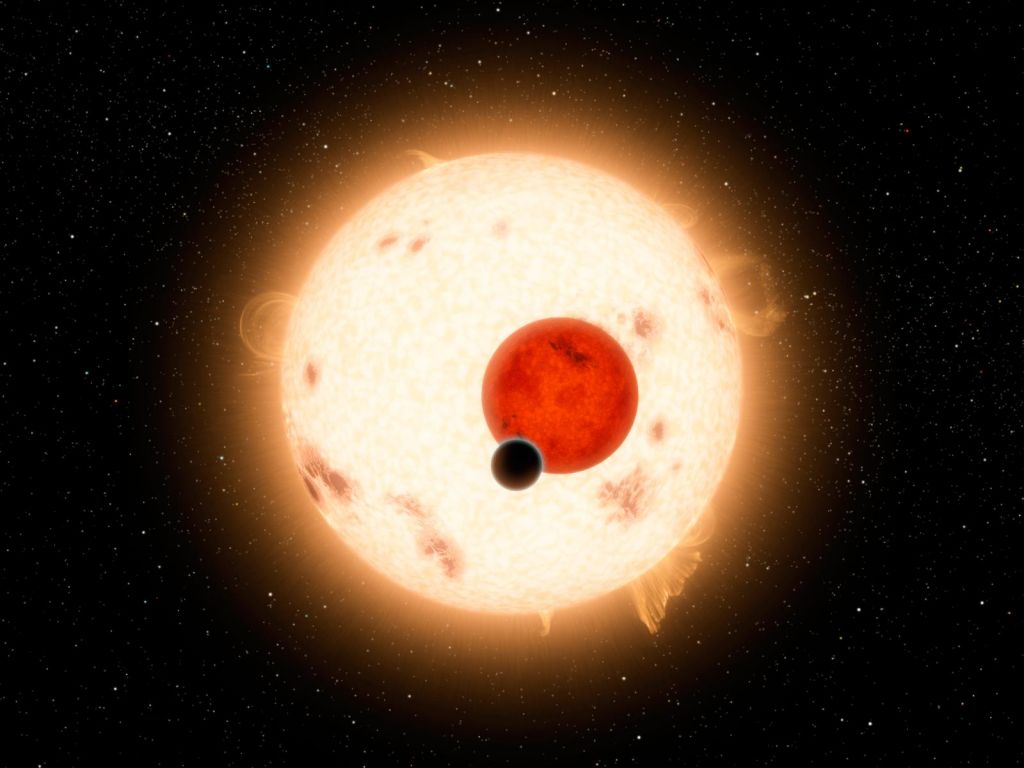"Tatooine-like" planet found in our galaxy
- Written by Cosmic
- Published in Space
- Read 953407 times
- font size decrease font size increase font size
- Media
The actual existence of a world with a double setting sun, as pictured in the film Star Wars more than thirty years ago, is now scientific fact. NASA's Kepler mission has made the first unambiguous discovery of a circumbinary planet -- a planet revolving around two stars -- 200 light-years from Earth.
As opposed to Star Wars’ Tatooine, the planet is very cold, gaseous and not believed to harbor life, however its discovery shows the diversity of planets in our universe. Previous studies have hinted at the existence of circumbinary planets, but clear evidence proved elusive. Kepler detected such a planet, known as Kepler-16b, by observing transits, when the brightness of a parent star dims from the planet crossing in front of it.
"This breakthrough discovery confirms a new class of planetary systems which could harbor life," Kepler principal researcher William Borucki said. "Given that many stars in our galaxy are part of a binary system, this means the possibilities for life are much greater than if planets form only around single stars. This breakthrough discovery confirms a theory that scientists have had for many years but could not prove until now."
A research team led by Laurance Doyle of the SETI Institute in Mountain View, Calif., utilized data from the Kepler space telescope, which measures dips in the brightness of more than 150,000 stars, to find transiting planets. Kepler is the first NASA mission able to find Earth-size planets in or near to the "habitable zone," the region in a planetary system where liquid h2o (water) can can be found on the surface of the orbiting planet.
Scientists discovered the new planet in the Kepler-16 system, a pair of orbiting stars that eclipse each other from our vantage point on Earth. Whenever the smaller star partially obstructs the larger star, a primary eclipse takes place, and a secondary eclipse occurs when the smaller sized star is occulted, or totally blocked, by the larger star.
Astronomers further more noticed that the brightness of the system dropped even when the stars were not eclipsing each other, hinting at a 3rd body. The additional dimming in brightness events, called the tertiary and quaternary eclipses, reappeared at unpredictable intervals of time, indicating the stars were in different positions in their orbit each time the third body passed. This confirmed the third body was circling, not merely one, but both stars, in a wide circumbinary orbit.
The gravitational pull on the stars, measured by alterations in their eclipse times, was a good indicator of the mass of the 3rd body. Only a very minor gravitational pull was detected, one that only could be caused by a small mass. The actual findings are described in a new study released Friday, Sept. 16, in the journal Science.
"Most of what we know about the sizes of stars comes from such eclipsing binary systems, and most of what we know about the size of planets comes from transits," said Doyle, who also is the lead author and a Kepler participating scientist. "Kepler-16 brings together the very best of both worlds, with stellar eclipses and planetary transits in a single system."
This discovery shows that Kepler-16b is an unfriendly, cold world about the size of Saturn and believed to be made up of about 50 % rock and 50 % gas. The parent stars are smaller than our sun. One is 69 % the mass of the sun and the other only 20 %. Kepler-16b orbits around the two stars every 229 days, comparable to Venus’ 225-day orbit, but lies outside the system’s habitable region, where liquid water could exist on the surface, because the stars are cooler than our sun.
"Working in motion picture, we regularly are tasked with producing something never before seen," said visual effects manager John Knoll of Industrial Light & Magic, a division of Lucasfilm Ltd., in San Francisco. "However, in many cases, scientific discoveries prove to be a lot more spectacular than anything we dare imagine. There's no question these discoveries influence and inspire storytellers. Their very existence serves as cause to dream even bigger and open our imagination to new possibilities beyond what we think we 'know.'
Media
Related items
Latest from Cosmic
- What would happen if a supernova detonates near earth?
- First Contact: Earth Welcomes Extraterrestrial Visitors
- Unidentified Aerial Phenomena (UAPs), UFOs, and Non-Human Intelligence: A Deep Dive into the Current Situation and Historical Connections
- Hubble telescope's iconic 'Pillars of Creation' view in infrared
- Astronomy Picture of the Day: Earth rise
2547 comments
-
 Tronsog Tuesday, 08 November 2022 01:08 Comment Link
Tronsog Tuesday, 08 November 2022 01:08 Comment Linkdosage of ivermectin for dogs with mange stromectol online kopen is dischem cheaper than clicks
-
 immuSty Sunday, 06 November 2022 14:41 Comment Link
immuSty Sunday, 06 November 2022 14:41 Comment Linkbuy generic stromectol online pharmacy without prescription where can you buy ivermectin in south africa oral stromectol for scabies
-
 Fewswinc Saturday, 05 November 2022 04:51 Comment Link
Fewswinc Saturday, 05 November 2022 04:51 Comment Linkhow much liquid ivermectin for humans where to buy ivermectin for birds how to give dogs ivomec
-
 Undura Friday, 04 November 2022 00:00 Comment Link
Undura Friday, 04 November 2022 00:00 Comment Linkwhere to buy ivermectin tablets in australia ivermectin tablets south africa price ivermectin for humans uk
-

-
 Neergown Wednesday, 02 November 2022 22:06 Comment Link
Neergown Wednesday, 02 November 2022 22:06 Comment Linkbuffalo bills casino concerts casino theme invitation online casino no deposit
-
 sowhepsy Wednesday, 02 November 2022 13:54 Comment Link
sowhepsy Wednesday, 02 November 2022 13:54 Comment Linkkalamazoo casino san manuel casino irish luck casino
-

-

-



